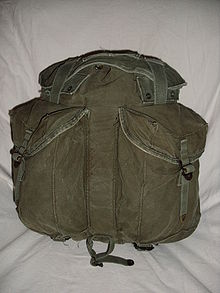ARVN backpack
The ARVN backpack is a lightweight backpack made of canvas with an integrated framework in the United States produced and as military assistance during the Vietnam War to the armed forces of South Vietnam was delivered.
history
In 1961 the Combat Development and Test Center of the United States Army was commissioned to develop a backpack for the ranger units of the ARVN ( Army of the Republic of Vietnam ). The intention was to create a backpack that could be produced in Vietnam with locally available resources.
The actual design was made by Eldon C. Metzger of Natick Laboratories based on his observation of the ability of South Vietnamese soldiers to carry food and ammunition for a period of 3 to 10 days.
The resulting “Ranger Pack”, also known as “Indigenous Pack” (“native backpack”) was initially produced in limited numbers from August 31, 1964. After a troop attempt, which was successfully ended on October 7, 1964, mass production began. 1.5 million pieces were produced by 1969. In 1970 the name was changed to "ARVN backpack". Production continued until Saigon's fall. A production in Vietnam itself did not materialize.
A special version with slightly different dimensions was developed for the armed forces of Thailand and introduced there in November 1965.
description
The ARVN backpack is made of olive green cotton fabric. It has a large main compartment that is closed by means of a drawstring through holes reinforced with metal eyelets at the top and also has a large rain protection flap.
The backpack has two outer compartments that are closed with flaps. There are “tunnels” between the back of the outer compartments and the outside of the main compartment through which longer items of equipment can be pushed.
On the upper edge of the main compartment below the drawstring there are two short belt straps with two metal eyelets each, to which items of the M1956 carrying equipment or the wire hooks of the M1910 equipment of the US Army can be attached. Such a strap is also located on the edge of the rain protection flap and in the middle of the sides of the main compartment. The strap on the rain protection flap is used in conjunction with a strap at the lower end of the main compartment to attach the folding spade . On the sides of the main compartment there are still two strap eyelets that are used to attach short lashing straps for a bed roll . The straps of the rain protection flap allow a blanket roll to be attached to the flap.
The integrated frame of the backpack was initially supposed to consist of rattan , but was then made of flat steel. The frame is X-shaped with a cross brace at the top and bottom. Two vertical straps and a hip belt keep the frame slightly curved to allow air to circulate between the backpack and the wearer's back. The top of the frame sits in the "pocket" at the top of the main compartment; the lower end is attached to two wire brackets at the bottom of the main compartment.
The shoulder straps are sewn to the top of the backpack; the lower end is hooked into a metal eyelet on the backpack with a snap hook.
In action
The ARVN backpack was not only used by the ARVN. Units of the US Army and the US Marine Corps also used this backpack as a replacement for their too small combat bags and the lightweight backpack , although the frame and shoulder straps, which were tailored to the smaller average size of the South Vietnamese soldier, are mostly right for the larger US soldiers were small or short.
The biggest disadvantage of the ARVN backpack is that the cotton material used is not water-repellent. Nevertheless, the ARVN is a compact, robust backpack that could be produced with the simplest of means.
See also
literature
- Shelby Stanton: US Army Uniforms of the Vietnam War . Stackpole Books, Harrisburg, PA, 1989, ISBN 0-8117-2584-7


